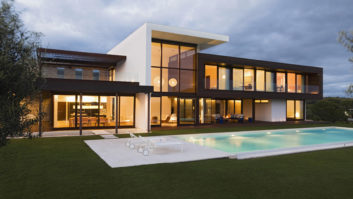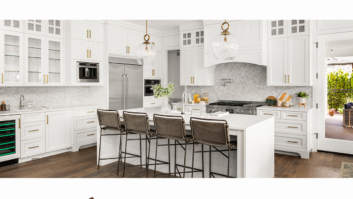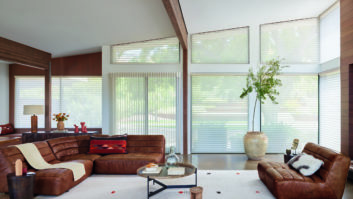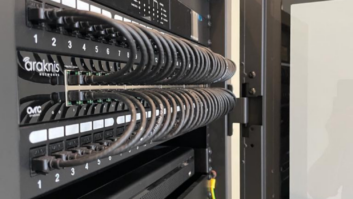Watching the keynote address for the Google I/O developer’s conference yesterday, I couldn’t help but think of the line in the old Broadway show tune, Annie Get Your Gun: “Anything You Can Do, I Can Do Better,” in the way Google, Apple, and Microsoft have presented their versions of our technology future.
At this week’s I/O conference in San Francisco, Google is showing what products can be created–either apps or hardware–that run its various software components. While there were many announcements, I’ll limit my analysis here to those of interest to the residential systems integration community and recommend to anyone wanting the full keynote, watch it on YouTube.

The Google TV UI will overlay selections for apps, games and other content over the program, as seen here.
There were some hardware-related announcements, but they were all about third-party products such as watches and wearables. Did you read any pre-I/O rumors prognosticating that an “Android TV” box would be introduced to compete with Roku, AppleTV, Amazon FireTV and all the rest? Yes, Android TV was discussed at I/O, but not as an available and defined piece of hardware, yet.
Google offered details of the new Android L” OS, which replaces its more cutesy-wootsie named predecessor KitKat. This OS is fun, but also very serious. Can it move apps from phone to car as Microsoft and Apple are doing (or improving)? Yes. Can it move content seamlessly across devices? You Betcha! Open a file from a Microsoft Office program and edit it on a Chromebook without Office? Sure!

Google TV users will be able to select a wide range of apps and games from Google Play.
While many were expecting the Android TV box, there was a more important focus on improving Chromecast functionality. I’ve been critical of Chromecast in the past for not being able to mirror from Android phones at tabs the way you can in iOS with an AppleTV. Well, anything “they” can do Google will soon be able to do as well, if not better. Along with SDKs for Chromecast that will make it easier for developers to create Chromecast-compatible apps, mirroring is on the way for compatible Nexus, HTC, Samsung, and LG devices. Later this year you’ll be able to press a “Cast” icon and what is on the device will be on the big screen.
All Chromecast owners will also be able to tailor the photos shown in screensaver mode or even use your own for a custom photo viewer. One of the presenters called this something that “…will please grandparents everywhere…” and he may not be far off. With a Chromecast plugged into an open HDMI input on a display and a device that costs under $35 you can turn the largest display into a digital picture viewer.

Google TV will be embedded in Sony, Sharp and Philips branded sets from TP Vision and have the support of the major silicon suppliers who provide the inner workings of displays that make this all possible.
Another thing that the new update will allow matches a feature alluded to as coming for Apple TV at Apple’s World Wide Developer Conference (WWDC). Chromecast users will no longer need to have the “sending/controlling” phone or tab be on the same wireless network as the Chromecast. When guests come over they won’t have to fiddle with Wi-Fi settings to push photos or apps to the screen. More importantly, the homeowner won’t have to give their Wi-Fi password to the guest and/or you won’t be involved in a weekend service call.
Many of the new features for Chromecast will also be part of Android TV, so it is important that you understand what the game plan seems to be. Again, there’s no Google- or Nexus-branded product now, or probably ever. Rather, think of Android TV as a mash-up OS and UI that will run the display, controls, apps, and all. Look back to CES to see how the Roku UI will be the viewer-facing interface for some new TVs from TCL and others and you get the idea. Yes, long-time Google partner Asus may come out with an Android TV STB, but that type of application doesn’t seem to me the goal here.

Chromecast will be updated later this year to allow for the same sort of mirroring from a phone (right) to a display (left) as iOS users enjoy now with an AppleTV.
With Android TV running the set, you get a familiar interface, access to apps, the ability to change input sources or channels, and use your phone or tablet as the remote with a simple “D-Pad” configuration. Using the phone or tab you’ll also have voice search for recommendations and the ability to play the ever increasing number of games in the Google Play store.
Yes, we presume that you’ll be able to drive this with a standard remote that comes with the product where Google TV is embedded, but it will be interesting to see how much of the app integration for control will be able to work in the framework of other control systems you use. That task is something you may have to figure out sooner than later as a somewhat stunning announcement at the I/O was that while there won’t be any standalone Google boxes, Google TV will power all 2015 model-year HD and UHD smart TVs from Sony, many from Sharp, and more from Philips/TP Vision. Future expansion will come with embeds in cable and IPTV boxes from numerous brands with extensive semiconductor support from Broadcom, ST, Nvidea, and others.

Google Fit will use a common API to allow more fluid interaction between sensors, devices and apps.
If all of these “TV-related” announcements weren’t enough for our channel, the “…we can do it, too” mentality extended into another area with the details revealed about “Google Fit.” Matching the concept of some of what Apple talked about at the WWDC, this API set will allow sensors, wearables, and apps to seamlessly communicate and share data.
This unified view of a user’s activity will remove the device vs. app silo on Nike and Adidas wearables and presumably more to come. No, there wasn’t any mention of using this API/app/sensor combo for home health along the lines of Apple’s “Health Kit,” but given the more open nature of Android it shouldn’t be too difficult for manufacturers, app builders, or even integrators to do that yourself. Remember, Android device penetration is greater than iOS, so if the market is there presumably the products will follow.
One other item from the keynote is yet one more “anything you can do.” At the WWDC there was talk of digital audio being enabled via the Lightning port and at I/O that was matched with the mention that “audio over USB” support was on the way for Android devices.
For all that was said, and there was much more, I was somewhat surprised that one device brand and their products was given nary a word and that this was one subject area left untouched. After spending about $3-billion for Nest, I would have thought that there would be mention at I/O of something related to home automation/device integration or anything close to that.
I found this silence deafening. I/O attendees famously leave with a bunch of new Android-based products. Last year it was a Google Glass and this year the takeaways included at least two watches/wearables, among other things. If home automation was on the front burner for Google, I would have expected a Nest thermostat or CO2 detector would have been in the tschostka basket, but the closest thing to Nest at I/O, at least in the keynote, was thinking about the straw that the Twitter bird sets down in.
All in all, there were many interesting things from this year’s Google I/O to make note of and watch as the software components are formed into use in devices and apps. It will not only be fun to see who, indeed, can “do better” as these developer’s conference announcements are turned into actual products and technologies.
CEDIA Fellow Michael Heiss is a contributing editor to Residential Systemsout of Sherman Oaks, CA.








